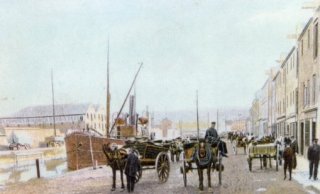It is more than two years since we listed, and gave details, of the more than thirty vessels sunk within the Carlingford Lough over the past century and a half, with great loss of life.
More than anything else, this disgraceful record testifies to the greed of traders and their unconcern with the lives of the sailors who worked for them.
Until the Second World War most ‘coasters’ – small commercial ships trading between Britain and Ireland – had neither electricity nor wheelhouses. They relied – as did sailors thousands of years ago – on compass and charts. Most were not fitted even with a radio and couldn’t therefore send out a distress signal in times of need.
Yet even the latest sea reports of today tell of ‘unstable’ vessels as being the continuing chief cause of ship wrecks.
Those we listed earlier did not include Newry vessels that went down elsewhere than within the Lough. We correct that now.
Four Newry vessels, coasters all engaged mainly in the importation of British coals, went down without trace in the twentieth century. Almost all Newry boats, the reader will remark, were named after trees or local places.
The SS Clonallon disappeared in 1904, followed four years later by the SS Orior. It was during World War II that the SS Privet (1940) and the SS Walnut (1941) went down. No crew members were ever heard of again! We have a tale to tell of the latter in a forthcoming article.
It was also in the first years of the last century that the Cloughmore went down in Lough Swilly with considerable loss of life. She was carrying grain from Liverpool to
The Great War was raging in
It is fortunate that no lives were lost in any of the following ships’ losses.
The Kilbroney went down on 4 April 1900: the Elm, on its way from Whitehaven on 6 July 1907 was also lost: so too was the Rostrevor on 12 April 1917 travelling from Newry to Manchester; and the Pine on 11 November 1936 and the Agba on 12 October 1940.
Other Newry ships were permanently lost when they ran aground. The SS Maple, carrying coal from Whitehaven to Briton Ferry; the SS Mango, on its way from Sligo to Coleraine foundered off Aranmore Island, Donegal; and finally the SS Poplar, on 14 October 1942 ran aground off Harrington in Cumbria, on its way to Whitehaven.
Newry people of old were historically proud of their sea-going record and considered themselves fortunate to find work on the boats or on the docks, loading and unloading the latter.
But we must never forget those who, as a consequence, paid the ultimate price!
PS Could those shipping experts on Threads come up with a few photographs of these ships for us, please?
